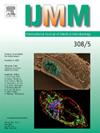Genomic insights into Klebsiella pneumoniae: Virulence, resistance, and transmission in South and Southeast Asia
IF 3.6
3区 医学
Q1 MICROBIOLOGY
引用次数: 0
Abstract
Background
Klebsiella pneumoniae has long posed a significant challenge in clinical settings worldwide, particularly due to its carbapenemase production and multidrug-resistant (MDR) characteristics. While extensive genomic studies of K. pneumoniae have been conducted globally, research in Asia, particularly South Asia, remains limited.
Objectives
This study aims to address and compare the genomic characteristics of K. pneumoniae isolates from South Asia and Southeast Asia, including virulence, antimicrobial resistance (AMR), plasmids, and mobile genetic elements (MGE) profiles, as well as potential transmission dynamics.
Methods
A total of 463 K. pneumoniae genomes were included from collected samples and public databases. All genomes underwent comprehensive analysis, including pan-genome profiling, multi-locus sequence typing (MLST), annotation of virulence factors, AMR genes, plasmids, and MGEs, as well as SNP distance–based analysis to infer transmission dynamics, using established bioinformatic tools.
Results
K. pneumoniae isolates exhibited diverse virulence determinants. Hypervirulent isolates were primarily associated with ST23 and ST86, and commonly harbour aerobactin, salmochelin, and rmpA. The majority of isolates were predicted to be MDR, with those from Southeast Asia showing a higher relative abundance of AMR genes associated with the antibiotic classes examined in this study. Among all isolates, the predominant carbapenemase-associated gene was blaNDM-1. Col440I_1 was the most prevalent plasmid replicon, although it did not co-occur with any AMR genes. Association between the IncFII_1_pKP9 plasmid replicon and resistance genes sul-5, blaCTX-M, and blaTEM was found. ISSen9 was the dominant MGE, frequently co-occurring with the plasmid replicons IncFIB(K)_1_Kpn3 and IncFII_1_pKP91. Transmission analysis indicated that the highest isolate similarity occurred within MLST and country. However, clustering based on plasmid replicon profiles revealed that some clusters comprised isolates from multiple countries.
Conclusion
This study provides a comprehensive analysis of the genomic characteristics and transmission patterns of K. pneumoniae in South and Southeast Asia, contributing to our understanding of its virulence and resistance mechanisms. These findings further suggest that plasmid replicons may play a critical role in shaping transmission dynamics and provide valuable insights to inform future AMR surveillance and control strategies.
肺炎克雷伯菌的基因组研究:南亚和东南亚的毒力、耐药性和传播
肺炎克雷伯菌长期以来在世界范围内的临床环境中构成了重大挑战,特别是由于其碳青霉烯酶的产生和多药耐药(MDR)特征。虽然在全球范围内开展了广泛的肺炎克雷伯菌基因组研究,但在亚洲,特别是南亚的研究仍然有限。本研究旨在研究和比较南亚和东南亚肺炎克雷伯菌分离株的基因组特征,包括毒力、抗菌素耐药性(AMR)、质粒和移动遗传元件(MGE)谱,以及潜在的传播动力学。方法共463张 K。从收集的样本和公共数据库中纳入肺炎基因组。所有基因组都进行了全面的分析,包括泛基因组分析、多位点序列分型(MLST)、毒力因子、AMR基因、质粒和MGEs的注释,以及基于SNP距离的分析,以推断传播动态,使用已建立的生物信息学工具。肺炎分离株表现出不同的毒力决定因素。高毒分离株主要与ST23和ST86相关,通常含有有氧肌动蛋白、盐切蛋白和rmpA。大多数分离株被预测为耐多药,来自东南亚的分离株显示出与本研究中检测的抗生素类别相关的较高的AMR基因相对丰度。在所有分离株中,碳青霉烯酶相关基因为blaNDM-1。Col440I_1是最普遍的质粒复制子,尽管它没有与任何AMR基因共同出现。发现IncFII_1_pKP9质粒复制子与抗性基因sul5、blaCTX-M和blaTEM存在关联。ISSen9是主要的MGE,经常与质粒复制子IncFIB(K)_1_Kpn3和IncFII_1_pKP91共同发生。传播分析表明,MLST和国家间的分离株相似性最高。然而,基于质粒复制子谱的聚类显示,一些聚类包括来自多个国家的分离株。结论本研究全面分析了南亚和东南亚地区肺炎克雷伯菌的基因组特征和传播模式,有助于了解其毒力和耐药机制。这些发现进一步表明,质粒复制子可能在形成传播动力学中发挥关键作用,并为未来的AMR监测和控制策略提供有价值的见解。
本文章由计算机程序翻译,如有差异,请以英文原文为准。
求助全文
约1分钟内获得全文
求助全文
来源期刊
CiteScore
9.70
自引率
0.00%
发文量
18
审稿时长
45 days
期刊介绍:
Pathogen genome sequencing projects have provided a wealth of data that need to be set in context to pathogenicity and the outcome of infections. In addition, the interplay between a pathogen and its host cell has become increasingly important to understand and interfere with diseases caused by microbial pathogens. IJMM meets these needs by focussing on genome and proteome analyses, studies dealing with the molecular mechanisms of pathogenicity and the evolution of pathogenic agents, the interactions between pathogens and host cells ("cellular microbiology"), and molecular epidemiology. To help the reader keeping up with the rapidly evolving new findings in the field of medical microbiology, IJMM publishes original articles, case studies and topical, state-of-the-art mini-reviews in a well balanced fashion. All articles are strictly peer-reviewed. Important topics are reinforced by 2 special issues per year dedicated to a particular theme. Finally, at irregular intervals, current opinions on recent or future developments in medical microbiology are presented in an editorial section.

 求助内容:
求助内容: 应助结果提醒方式:
应助结果提醒方式:


